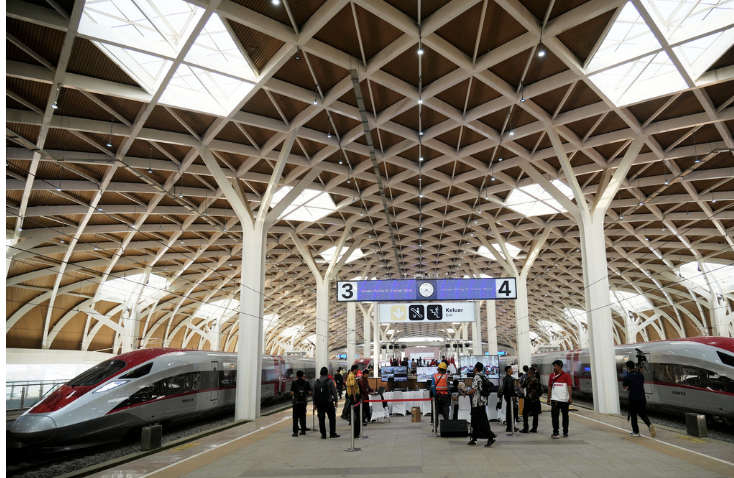Indonesia Launches First High-Speed Railway with Chinese Funding
The opening of Indonesia’s first high-speed railway was delayed almost four years. (AP Photo/Achmad Ibrahim)
This past Monday, Indonesian President Joko Widodo inaugurated the country’s first high-speed railway in Jakarta, Indonesia, marking a new phase in the region’s transportation system. After years of delays, the Chinese-backed, $7.9 billion project officially opened to the public.
The train, named “Whoosh,” stands for an acronym that translates to “timesaving, optimal operation, reliable system” in Indonesian. The 88-mile long railway connects Jakarta with Bandung, the capital of Indonesia’s West Java region, and is set to cut travel time between the two cities from three hours to just around 40 minutes.
Scheduled for an initial launch in 2019, the project has encountered a series of setbacks, ultimately delaying its opening to 2023. This prolonged timeline extends the project's development to nearly seven years since the railway first broke ground in 2016. Disputes over land acquisition, the COVID-19 pandemic, and budget overrun all presented significant obstacles.
Looming in the background of this achievement was China’s continuing involvement in the region, an extension of its years-long Belt and Road Initiative (BRI). The BRI, which began almost a decade ago, has since evolved into a substantial geopolitical project. It utilizes infrastructure investment to extend Chinese influence, technology, and capital globally, amassing a total BRI engagement of over $1 trillion. In 2023 alone, China struck 103 new deals worth a cumulative $43.3 billion.
For the first time, investment made up more than 50% of BRI engagement, much of it coming from companies in the Chinese private sector who partner with the governments or state-run corporations of the countries they invest in. Whoosh is no exception: the railway is run by PT Kereta Cepat Indonesia-China (PT KCIC), a joint venture between four Indonesian state-owned companies and the private Beijing-based China International Railway Co. Ltd.
China’s substantial investment is indicative of its intent to assert its presence among the Association of Southeast Asian Nations (ASEAN), particularly as the United States and its allies are pushing back on China’s encroachment in the South China Sea.
Indonesian President Joko Widodo inaugurating the region’s first high-speed railway, “Whoosh,” in Jakarta. (AP Photo/Achmad Ibrahim)
In 2021, China launched the $6 billion Laos-China Railway, a semi-high-speed railway that has fostered an uptick in travel between the two countries and enabled economic development in debt-ridden Laos. At the same time, the railway is a step towards entrenching Chinese influence in the region and will serve as a gateway for the development of further projects throughout Southeast Asia. Beijing intends to extend the Laos-China Railway even further south to Kuala Lumpur and Bangkok, physically and economically linking Laos, Thailand, Malaysia, and their neighbors back to China.
Essential to the BRI pitch is the prospect of economic growth and technological development. However, according to some experts, the debt Indonesia accumulated from the long-delayed and far-over-budget railway project may very well outweigh Whoosh’s ultimate economic benefits. President Jokow of Indonesia allowed the government to use state funds as the budget continued to balloon, further burdening an Indonesian economy still recovering from the pandemic. While the railway uses electrical energy—a continuation of China’s increasingly environmentally-conscious investments—the actual environmental benefits could be limited. Competing toll roads in the vicinity have the potential to cause underutilization, reducing Whoosh’s cost-effectiveness.
With the BRI again expanding and more rail projects slated to start across Southeast Asia, infrastructure investment may again become a major tool for China to exert its influence. It remains to be seen the true economic and cultural implications that these developments will have for the countries that China chooses to invest in.


